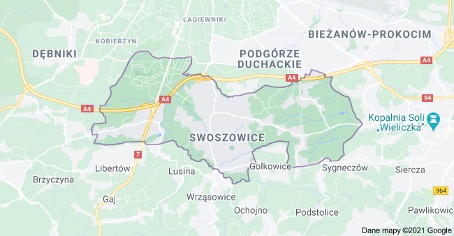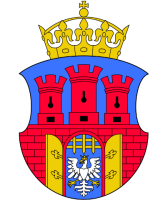
Source: Google Maps on 01/21/2021.
The most important tourist attractions of Krakow include:
- Wawel - in the Royal Cathedral over the centuries there have been many coronations, funerals and burials of Polish monarchs and principals. It is the third church on this site, consecrated in 1364. The original was founded in the 11th century by King Bolesław I the Brave and replaced with a Romanesque building around 1140. When it burnt down in 1305, only the crypt has survived. D attractions include: the Cross, the Zygmunt Chapel, the Sigismund Bell, the Crypt of St. Leonard and the Royal Crypts.
- St. Mary's Church - Overlooking the Main Square, this striking brick church, known simply as St. Mary's, is dominated by two towers of different heights. The first church was built here in 1220, and after its destruction during the Tatar invasion, the construction of the basilica began.
- Altar of Wit Stoss - ornate interior is richly decorated in different styles and colors. However, attention is drawn to the monumental altar, carved in linden wood by Veit Stoss in the years 1477-1489.
- Market underground - the exhibition presents archaeological excavations carried out in 2005-2010. Standing on the cobblestones of Krakow's historic market square, it would be easy to miss the 4,000 square meter archaeological structure and the most modern multimedia extravaganza that is just a few meters underground. Archaeologists even reached 5 meters to the Main Market Square in Kraków. Thanks to their work, 11,000 exhibits were found. They are related to the salt, lead and copper trade as well as the ancient everyday life of Krakow.
- Town Hall Tower - it is a Gothic tower from the 15th century, located at the Main Square in Krakow. It is 70 meters high. Once it belonged to the main administrative buildings of Krakow, today it is rather a tourist attraction with mysterious architecture and an interesting atmosphere.
- Cloth Hall - it is a great market hall built in the 13th century and successively expanded in the following years. It is located in the heart of the Main Market Square in Krakow. A branch of the National Museum is located on the first floor.
- Dragon's Cave - limestone cave near Wawel. It is one of the most famous Krakow attractions related to the 13th-century legend of the Wawel Dragon. According to stories, a cruel dragon once lived in the cave, now part of the Wawel Castle complex. He terrorized the city for months, requiring weekly donations of cattle. If the townspeople do not provide the required number of animals, the dragon will burn and devour the people. In 1972, to commemorate the creature, a sculpture of the Wawel Dragon by Bronisław Chromy was placed at the entrance to the cave. The cave is 270 meters long and visitors can visit 81 meters.
- Elvis Presley Avenue - there are thousands of monuments in honor of the King of Rock and Roll, but none of them are like the one in Krakow's city park.
- Old synagogue - one of the oldest synagogues in Poland, built around the 15th century. Until World War II, it was the central synagogue. Since 1958, it has been a branch of the National Museum in Krakow. Tourists can see items of ceremonial art.
- Remuh Synagogue - It is the only active synagogue in Krakow. Jews from all over the world come to this place to pray over the tomb of Rabbi Moses Isserles, or Remuh for short.
- Pharmacy Museum - Has a collection of 22,000 items including old laboratory equipment, rare pharmaceutical instruments, barrels, books and medical documents.
- Bunkier Sztuki - Bunkier Sztuki has three floors of contemporary works, ranging from young Polish local artists to international names. There are photos, paintings and multimedia works.
- St. Wojciech - This tiny church is definitely worth visiting if you are on the Main Square in Krakow. It is small but delightful and with an amazing ceiling. The paintings around the dome have been beautifully restored.
- Stained Glass Museum - you can learn here how stained glass windows of Polish churches, palaces and residences are made.
- Grunwald Monument - like most of Krakow's works, the original was quite badly damaged during the war. But this very large and striking monument was rebuilt close to its former glory and unveiled in 1976.
- Historyland - a modern way of learning about Polish history. History comes alive. Totally amazing and informative experience. The Lego exhibitions are very well done and the information they contain is very informative.
- Jan Matejko House - a small museum dedicated to the Polish artist Jan Matejka. He came from Krakow and was one of the most important Polish artists. His life, some of his paintings and furniture have been preserved in this house.
- The Franciscan Church - The fact that this is the church where John Paul II worshiped before becoming Pope makes it truly special. The Church always seems to be full of believers.
- The papal tram - tram No. 8 is commonly known as the "papal" tram, because when driving from Bronowice along the following streets: Franciszkańska, Dominikańska, Św. Gertrudy, Stradom, Krakowska, Kalwaryjska, Wadowicka and Zakopiańska - it connects the most visited places associated with John Paul II in the city center ( e.g. the Palace of Krakow Bishops, the Wawel Cathedral) with the Sanctuary of Divine Mercy and the John Paul II Center "Do not be afraid!" in Łagiewniki The tram also runs through the charming places of Kazimierz and Podgórze.
- Water tram - To make the sightseeing of the city more attractive and connect the facilities located on the tourist routes along the Vistula River, the Krakow Water Tram was launched. The tram runs from May 1 to September 30 every day from 10.00-18.45. Water Tram cruises are served by vessels that can accommodate up to 12 passengers and a ship that can take up to 90 passengers at a time. All units allow the transport of bicycles, some are also adapted to the transport of disabled people. The length of the hiking trail is approximately 10 kilometers and includes 13 stops. The final stops are located near Galeria Kazimierz and the monastery. Benedictines in Tyniec.
- Streets of the Old Town - in the 14th century, Krakow had 42 named streets. The earliest documents are: Grodzka, Wiślna, Floriańska, Bracka, Sławkowska. Street names were invented spontaneously by the inhabitants of the city until the beginning of the 19th century, guided mainly by topography and tradition.
- Jewish Kazimierz - Krakow's Kazimierz is a special place, shaped by the centuries-old Christian-Jewish neighborhood. Jews appeared in Kazimierz in the mid-14th century and until the beginning of the 19th century they lived in the "Jewish town", enclosed by today's Miodowa, Św. Wawrzyńca, Wąska, Józefa and Boża Ciała Streets. It was an autonomous enclave - Jews ruled over themselves. in it on their own - they had only the king over them, on whose behalf the governor of Kraków exercised power.
- Fortifications - Krakow is one of the few cities in Europe where, in addition to the almost completely preserved Austrian fortress (Krakow Fortress), also older buildings of defensive architecture have survived: the remains of medieval city walls, fortifications of the Wawel Hill and fortifications from the times of the Kościuszko Uprising (18th century) .
- Garden of Experiences Stanisław Lem - Garden of Experiences Stanisław Lem is a branch of the Museum of Municipal Engineering in Krakow. On the area of over 6 ha of the park there are: devices demonstrating the phenomena of physics, geological exhibition "Geo-gródek", sensory exhibition "Smell", green labyrinth with quotes from Stanisław Lem - "Lem-birynt".
Tourist attractions in the Swoszowice area:
- Mogilany - a Renaissance manor house from the 15th century. The seat of the printing house from 1567, where the works of Mikołaj Rej were printed, at present there is a classicist palace from the beginning of the 19th century. - Conference center of the Polish Academy of Sciences. Church from 1604, extended in the 19th century. Manor from the 18th century.
- Tyniec - Benedictine Abbey, Gothic monastery church from the 15th century, Romanesque monastery building with Gothic cloisters from the 15th century. Geometric park from the 18th century with terraces.
- Wieliczka - the Salt Mine since the 12th century - a world-class tourist attraction, a monument included in the UNESCO World Heritage List. A labyrinth of chambers, workings and corridors. The Krakow Saltworks Museum. Historic churches of St. Clement and St. Sebastian.
Gaj - a historic church from the second half of the 15th century, extended in the 19th century. A manor house with foundations from the 18th century.
- Głogoczów - the court lamus from the 18th century and the church from 1812.
- Lusina - the manor house from 1688. The remains of the spa park with magnificent old oaks.
- Droginia - an 18th century manor house and a landscape park.
- Wrząowice - 18th century manor. Historic decorative and landscape park.


